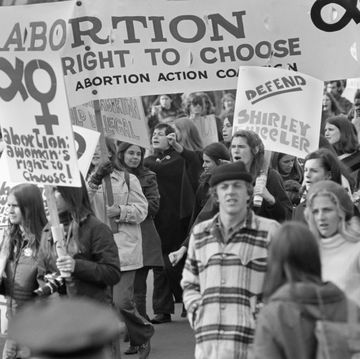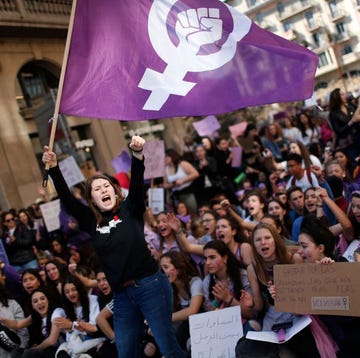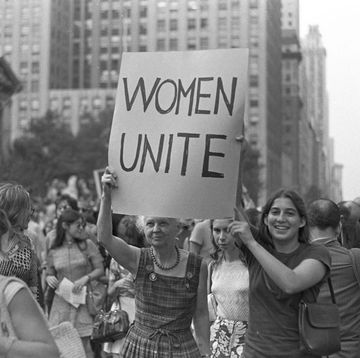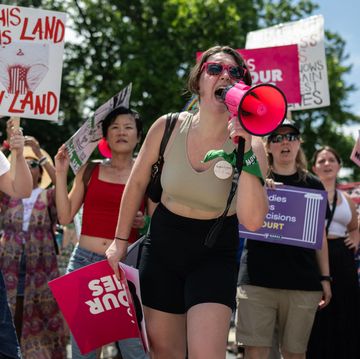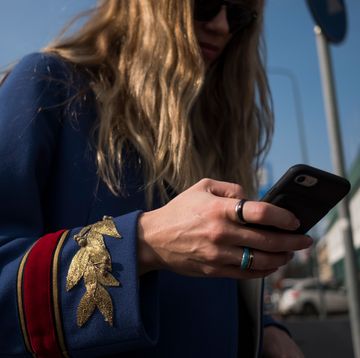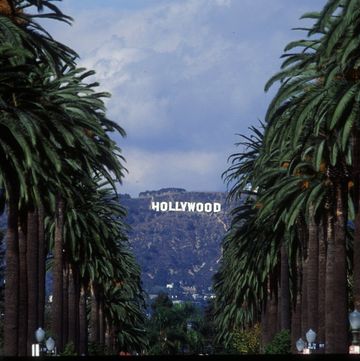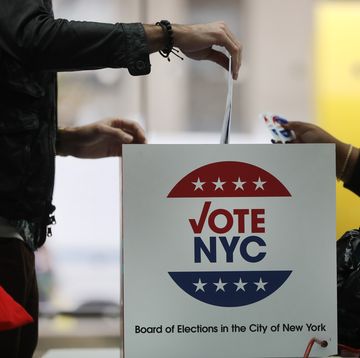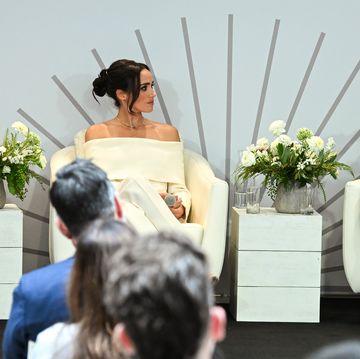As the crowded and highly contested primary race to represent New York's 10th Congressional District winds down, Carlina Rivera wants New Yorkers to know that she's "the candidate for people who love NYC."
Rivera, a member of New York's City Council since 2018 and a born and raised New Yorker herself, tells BAZAAR.com, "I absolutely feel so honored that I can even run for Congress from very humble beginnings, but the city has given me everything."
She is among the throng of Democratic candidates putting themselves forward as the best representative for the newly redrawn district, which covers prime neighborhoods across the expanse of lower Manhattan and Brooklyn, such as TriBeCa, Greenwich Village, and Park Slope.
In some ways, Rivera embodies those virtues associated with the party's progressive flank, bucking up against the institution by infusing old-fashioned Democratic sensibilities with a left-leaning agenda in service of social equity and justice. In other ways, she can be viewed as a liaison between liberals and establishment Democrats, with her historic support of controversial rezonings in the neighborhoods of SoHo and NoHo, and the East Side Coastal Resiliency Project.
"We need to really govern by our set of values, our progressive genuine values in lifting up families," she says. "We also have to ensure that we're achieving progress however and wherever we can get it."
Before voters enter the polling booths on Election Day, August 23, BAZAAR.com catches up with Rivera to talk about her plan for reproductive rights, climate change, affordable housing, and more. Read our conversation below.
In these conversations that you're having with the constituents of NY-10, what are you finding is the most pressing issue?
On the trail, there are a lot of issues that come up: addressing the housing shortage, thinking of the effects of climate change, and how we really build a more resilient and livable city. Affordability comes up a lot. What we're going through right now in New York City, with $5,000 being the median rent and [needing] to make a six figure salary to make monthly expenses, it is getting hard and harder for people.
The best thing about New York City is the promise that you can come here, you can take care of your family, you can follow your dreams. That is becoming more and more difficult for folks. So affordability comes up over and over and over again. When I'm hanging out with the arts and culture workers and our teachers and our nurses, we want to ensure that our message is very clear that we want to build a future where everyone can see themselves.
When I'm out on the trail, talking to women specifically, you know, health care and abortion access comes up time and time again. We're having really deep conversations about the future of Roe, on the access to contraception. That is something that I've been working on for a long time.
Obviously, reproductive justice has dominated so much of the conversation throughout this election season. And recently, you had joined forces with a fellow opponent, former representative Liz Holtzman, to encourage New Yorkers to "send a woman to Congress." To me, seeing this joint effort of teaming up with a fellow candidate, another woman in the running, seemed to very strikingly illustrate what exactly is at stake this year when it comes to reproductive freedom. Could you talk a bit about that urgency to vote in a pro-choice candidate?
Choice is on the ballot in NY-10. Members of Congress from progressive districts like NY-10 have an opportunity to define the contours of blue America post-Roe. Twenty-two states are already in the process of banning abortion. Fifty years after Roe, half the country has lost a constitutional right. When we knew that abortion rights were at stake years ago, I went to the rallies, but I didn't just say the right things. I got to work.
Back in 2019, when I helped make New York City the first city in the nation to directly fund abortions for both New Yorkers and women traveling here from out of state, we created a model for the rest of the nation. And in June, after it became painfully clear that the Supreme Court intended to overturn Roe, I introduced a bill that we passed to require all city-run health care facilities to provide abortion pills, to provide medication abortion, free of charge. … This bill is now the law of the land here in New York City.
Standing with Liz was to really underline [that] the fight for reproductive freedom didn't just begin with the Supreme Court's Dobbs decision overturning Roe. It's made the fight all the more urgent. And it won't stop here. They're coming after birth control access guaranteed by Griswold. Ninety-six percent of Republicans in the House voted against codifying access.
There are already too many politicians who lack the courage—really spineless Democrats even who aren't willing to fight for our own rights or reproductive freedom. That's how we got here. That's not what we need in New York. In one of the most pro-choice districts in America, we need a fighter for our rights. There are millions of people across the country counting on us to send a champion to Congress to protect them from Republicans who are every day persecuting and prosecuting both people seeking reproductive health care and the doctors who provide it.
But we have to be realistic. We can't wait on institutional reforms that could take years to fully realize. We need leaders who will take action right now. And I have proudly shown that I know how to do that.
Earlier you mentioned this anxiety that a lot of New Yorkers are feeling when it comes to housing. If elected, what options are you thinking of exploring in Congress to ensure that New Yorkers have access to affordable housing?
In NY-10, we have approximately 18,000 families living in public housing and 96 percent of them live in a flood evacuation zone. So preserving public housing, fully funding it, ensuring that we are protecting families from flooding and the effects of climate change, is really a priority of mine. We had thousands of families flooded after Hurricane Sandy, really creating years-long adverse effects, [like] exacerbating mold in homes.
There are some great pieces of legislation, including the Homes for All Act. There's legislation that explores linking federal dollars to building housing by using less restrictive zoning. I think that's certainly something we have to explore. I've certainly led on issues in building housing in New York City, in transit-rich high-opportunity areas. And I'll continue to be unapologetic about that, encourage my colleagues to build more housing in the suburbs as well, and really ensure that we're expanding Section 8 vouchers.
We need to create hundreds of thousands of new homes. Right now, with all the jobs that have been added to the economy over the past couple decades, it is estimated we need more than 300,000 new homes in New York City, about four million across the country. So this is a crisis in affordability, in access, that is being felt nationally. There are very few members of Congress who have made affordable housing not even a top-three issue. I'm gonna continue to fight for that, whether it's vouchers [or] developing more housing and supportive housing, which provide those supportive services, especially for those who need mental health care.
If my family didn't have access to Section 8 that covered the rent, I wouldn't have had stable housing growing up. Especially in times of inflationary periods, housing provides the stability that people need. So we have to make that a top issue.
You mentioned that a lot of New Yorkers are in areas where there's a flood evacuation risk. I did want to ask you about this and about your climate change policy in relation to some of the backlash you've received about East River Park. Some of your critics have called the demolition of this park, the cutting of nearly 1,000 trees, an act of "environmental racism." They've accused you of not doing enough or not looking into other alternatives that might have otherwise saved this green space. How do you respond to these critiques, and how do you reconcile it with your climate change platform?
Well, we are saving the park to be open and accessible for future generations. That is the plan the community ultimately came up with. We're gonna rebuild and fortify East River Park to be a world-class park that our community certainly deserves with all of the amenities that existed before and even more trees than we had previously.
The plan as it stands—phasing in the construction and ensuring that we are preventing future flooding—is something the community really came together to organize around. Throughout many, many years, actually, since Hurricane Sandy, we were here all preparing for a storm that we could never have expected its repercussions and its consequences: Forty-four New Yorkers died, economic devastation, people displaced from their homes forever. We knew we had to do something to ensure that we actually earned the investment. We won a national competition called Rebuild by Design, and we earned federal dollars to do this project. Having this city match and even exceed the federal dollars was a very big deal for really also being the model.
This is the first project of its kind in the city and the first investment of its kind in the country—and it's directly adjacent to families living in public housing. The leaders of this were families in public housing, the presidents of local NYCHA tenant associations—that's our public housing system here in New York—our arts and cultural organizations, environmental justice leaders. We even had our local youth sports teams involved, because they would be the ones that would be using the park for years and years ahead.
Environmental injustice would be allowing another major storm to flood our lower-income communities who are mostly people of color and do nothing to protect them. That is just not something that I would do. That's not something that my community wanted, and I'm really proud of where we are today. When the park is open and protecting us for the next flood and years and years down the line, we know that this will be an open space for multiple generations to come.
I think when we talk about housing, when we talk about environmental justice, that goes hand in hand with community safety. In the past, you've spoken about your support for investing in community-led initiatives rather than solely relying on policing. Would you be able to illustrate what some of these initiatives might look like?
These complementary strategies to law enforcement are all about investment. The safest communities are the ones that are invested in. What we have to ensure what we're doing is also treating gun violence as a public health crisis. We have violence interrupter programs that are in our public hospital system right now. They are going to victims of gun violence. They are sending credible messengers, people from the community, to have those discussions and figure out how does someone get into that position where they are currently being treated in the hospital as a victim of gun violence.
We have a great program in NY-10 called Avenues for Justice, which is youth focused, really developing workforce opportunities, exploring arts programs. NeON Arts in the city is another one that really uplifts young people as an alternative, in exploring their talents and photography and painting. And we have to ensure that we also have our community centers that are open late, that are helping young people get a job or get ready for college.
That sort of investment in good housing, in health care services, in great education programs, and in ensuring that every family has access to healthy food [addresses] those root causes of poverty and crime. That is how we can build safe communities with people who understand that the government is there supporting and working for them.
We know who is disproportionately incarcerated and detained in places like Rikers Island, where there is a humanitarian crisis unfolding as we speak. Those are typically low-income Black and Brown people. We have to ensure that we have representatives who have a deep understanding of what's going on in our communities. Even in New York, where we are, previously we had some of the strongest gun control laws in the nation before the very conservative and extreme Court struck down the concealed-carry law. We are a place that is still plagued by gun violence, especially in low-income communities.
These complementary strategies to law enforcement and this deep, deep investment has to be a focus of every single level of government. I'll continue to push for that. Knowing the programs that are working and how federal dollars can really increase programs and services, that's something that I'm going to be really excited to lead on.
What's your reaction when you hear things like Mayor Eric Adams calling for more policing on the subway or on the streets of New York City as a solution to fighting gun violence?
We have to have a multi-prong strategy. We can't arrest our way out of the problem. We have to use smart public safety tactics. Certainly there are neighborhoods where presence of public safety and visibility is something that they have asked for. I feel that our subway system especially really is deserving of more attention and more investment. We're one of the last cities with this great transit system to implement infrastructural upgrades, to check on a robust and comprehensive security system. To ensure that we have solutions coming from multiple fronts, that goes back to where we're investing in our communities.
I'm someone who has really been vocal on transportation being a great equalizer. I feel our subway systems really need a lot of care and attention. I want to make sure that we have a voice in Congress, because we have too few setting the urban agenda. Because we are so dense and diverse and have so many communities with nuanced needs—whether it's anti-Asian hate or antisemitism—taking those issues, implementing smart public safety, and ensuring that we're investing in our communities, that is where my focus is gonna be.
I think how the mayor is going to put forward a plan that really takes on housing, health care, food, and education—that's the plan I'm really looking forward to him putting forward.
I think we've been seeing a shift in recent years among voters who are feeling demoralized and frustrated by Democrats in office. At the same time, we've also been seeing an influx in a younger cadre of elected Democrats who are attempting to reinvigorate the party with a more progressive agenda. What do you think the future of the Democratic Party looks like? And do you think it's possible for voters' faiths to be restored?
Reinvigorate the party by delivering results. People are very frustrated by a lack of action in Washington by Democrats who have not stood up for issues like Medicare for All, like passing a Green New Deal, especially like prioritizing abortion access and access to contraception. That's why we're in this position 50 years later.
How you restore their faith and their trust, it's all about effectiveness. When we deliver on the issues that we're fighting for, that's when people can say, "Well, you know, my representative is working for me. They're pushing for access to contraception. They're ensuring that we are creating more housing. They are discussing mental health constantly in terms of our need after a destabilizing pandemic."
We need to really govern by our set of values, our progressive genuine values in lifting up families, and then we also have to ensure that we're achieving progress however and wherever we can get it.
I have one more question for you, just to end on a lighter note. What is your favorite place to eat in NY-10?
Oh, my gosh, this is such a good question. I have a few favorite places. I love going to Casa Adela on Avenue C where you can get Puerto Rican cuisine by a family who has been there for many, many years. Just a few blocks away, I have this restaurant I really love called Il Posto Accanto on East Second Street in the East Village. But when I'm in Brooklyn—I mean, we have such great restaurants in NY-10, it's almost hard to choose, but I love Rucola on Dean Street in Brooklyn, or Lucali, which is another great pizza spot.
I know, it's a loaded question.
Yeah. Like, okay, then you get to decide like, "What outfit am I wearing tonight? What's the vibe? What's the scene at this place?" That's the best part of New York, is that there's so much self-expression and what people wear and their shoes, and just the way that we're kind of all moving around the city. It's just a great place, and I want it to continue to be the greatest city in the world.
I absolutely feel so honored that I can even run for Congress from very humble beginnings, but the city has given me everything. What I like to tell people is I'm the candidate for people who love NYC, and I'm gonna continue to bring that message with me everywhere.
This interview has been edited and condensed for clarity.
As an associate editor at HarpersBAZAAR.com, Chelsey keeps a finger on the pulse on all things celeb news. She also writes on social movements, connecting with activists leading the fight on workers' rights, climate justice, and more. Offline, she’s probably spending too much time on TikTok, rewatching Emma (the 2020 version, of course), or buying yet another corset.







